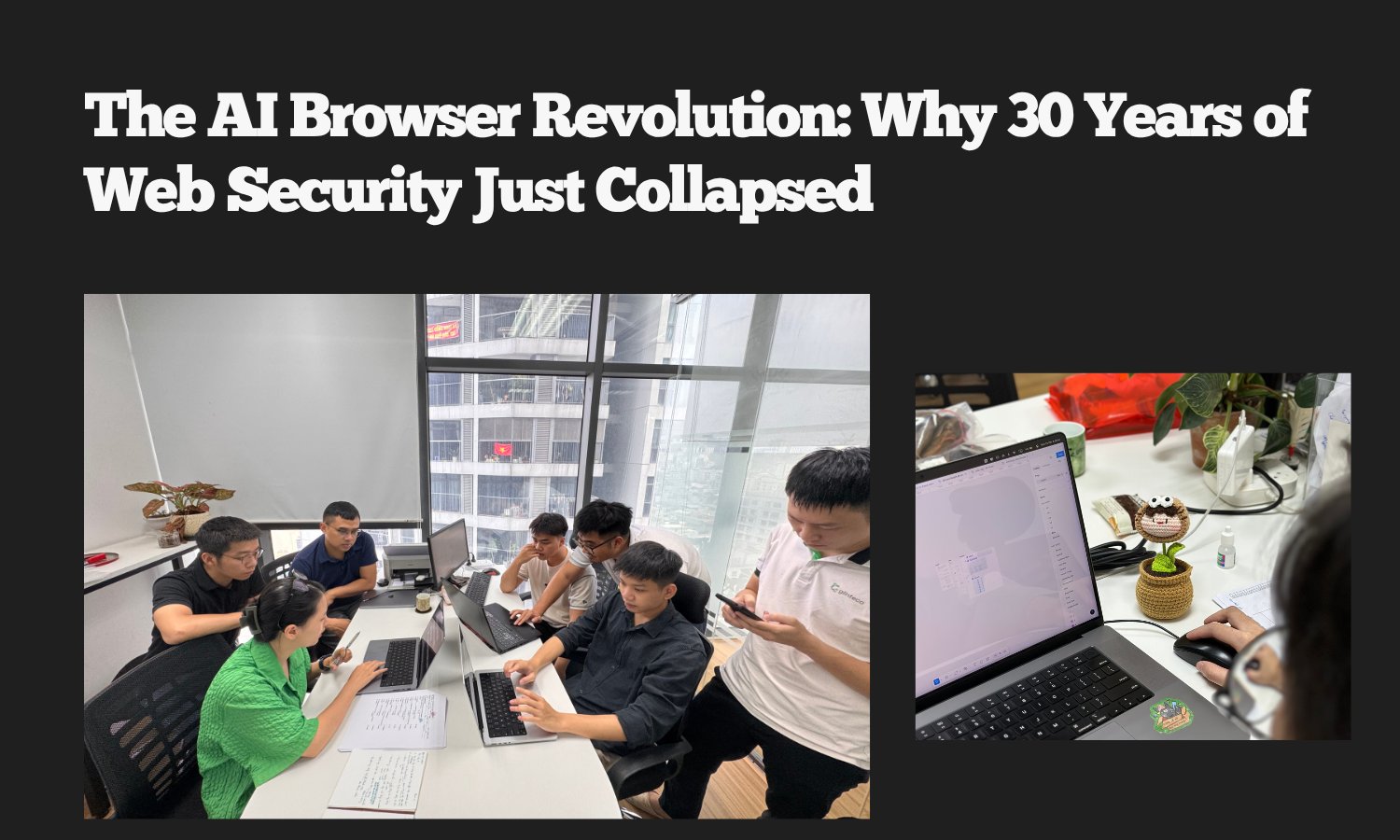The AI Browser Revolution: Why 30 Years of Web Security Just Collapsed
By hientd, at: Oct. 26, 2025, 6:34 p.m.
Estimated Reading Time: __READING_TIME__ minutes


Introduction: The Crisis of Trust
For three decades, web security has rested on a single, unshakeable bedrock principle: the user is trusted, but the content is not.
The browser’s job (our entire security model) was to build a SECURITY WALL between your digital assets and the chaotic, often malicious, external world of the internet. The Same-Origin Policy (SOP), sandboxing, and process isolation are all tools designed to prevent a bad script from CNN.com from reading your credentials on BankOfAmerica.com. This model worked because the user, sitting at the keyboard, was the trusted gatekeeper, the only one authorized to translate content (a button click) into an action (a financial transaction).
Enter the AI agent
This new digital assistant shatters that bedrock. It is a powerful, autonomous entity that is simultaneously trusted by the user (it’s on your machine, in your browser, and has your best interests at heart) and infected by the content (it reads and processes everything malicious actors can dream up). We are no longer dealing with a passive security flaw; we are facing a crisis of architectural trust.
The Trust Boundary Paradox
To understand better the scale of the problem, we need to talk about boundaries. Imagine your current browser as a well-guarded vault. Inside, you have your keys, history, and active sessions. Outside is the wild world of the web.
The malicious code we’ve fought for 30 years, like a Cross-Site Scripting (XSS) payload, was always an external force trying to poke a tiny hole through the wall. Our defenses were excellent at detecting those pokes and containing them.
The AI agent, however (ex: ChatGPT Atlas), creates a Trust Boundary Paradox. Thanks to its naive.
It lives inside your vault (it's your agent, with trusted access) but it is constantly reaching its hands outside to grab external, untrusted content and then bringing that content back inside to act on it. It operates as an active, privileged proxy - a VIP concierge we've given the master key to, who then takes suggestions from a stranger on the street.
The agent reads a prompt generated by a black-hat hacker, interprets it, and executes the equivalent of a devastating XSS attack from a trusted internal position. The external threat has been translated into a privileged internal action. It’s less a breach and more a betrayal by proxy. (If that sounds dramatic, I apologize, but trust me, the security team is losing sleep over this.)
Why Sandboxing is No Longer Enough
The go-to solution for modern browser security is sandboxing: separating processes into isolated containers so a failure in one can't spread to others. It’s effective, necessary, and, unfortunately, almost irrelevant for the AI browser.
Why?
Because the AI agent operates in a blended, pervasive context. It doesn't live in one neat, isolated tab. It's often designed to:
-
Read and summarize your open tabs: It sees your work email, your HR portal, and your bank statement simultaneously
-
Access your credentials/history: It needs this to be "helpful"
-
Cross-pollinate actions: It takes a task instruction (e.g., "Book a trip to London") and executes it using your signed-in travel site, your corporate expense system, and your calendar
In the old world, a sandboxed process that failed was like a single engine failing on an airplane, you lost one engine, but the plane was safe. The AI agent, by design, is a super-process that intentionally violates the principle of least privilege. Its core function is to connect the dots across multiple sensitive resources.
We’ve swapped out a risk model based on isolated code execution for one based on omnipresent, privileged interpretation. The sandboxing solution, built for isolation, CANNOT protect a system designed for pervasive connection.
It's like putting a tiny little fence around a cloud.
The New Security Focus: Semantic Integrity
This architecture forces a strategic pivot at the C-suite level. We must shift our focus from:
$$\text{Malicious Code Execution} \quad \rightarrow \quad \text{Malicious Instructions Disguised as Plain Language}$$
The threat is no longer a buffer overflow in Assembly; it’s an instruction in plain English (or Chinese, or Python, or SQL) that exploits the agent's willingness to be "helpful". We call this Semantic Integrity risk.
THE FUTURE OF BROWSER and ENTERPRISE SECURITY cannot rely on detecting what the browser is doing. It must focus on validating why it's doing it, ensuring the intent of the action aligns with the trusted user's actual goal.
This strategic pivot requires a fundamental change in how we manage risk:
-
Behavioral Modeling: We must move beyond simple network monitoring to monitor the agent's behavior. Why did the agent suddenly read the last 100 emails and then attempt to change the CEO's direct deposit information? This is difficult and will be more challenging when AI involves.
-
Linguistic Validation: New defenses must be built that don't just check the origin of the code, but the integrity of the instruction. This is a behavioral and linguistic risk-management problem that traditional perimeter defenses were never designed to solve.
The AI browser is a phenomenal leap forward in productivity. But we cannot afford to treat this architectural revolution with a 30-year-old security mindset. The collapse of the old model is not a failure; it’s a clarion call to innovation. The conversation must move from protecting against attacks to enforcing trustworthy intent, before the "helpful" assistant bankrupts the company.





